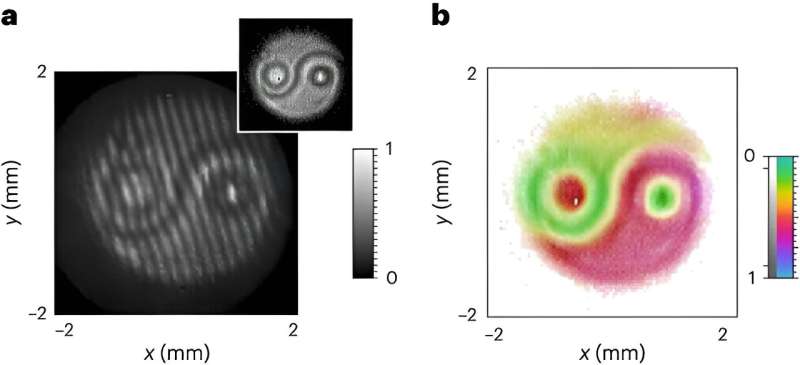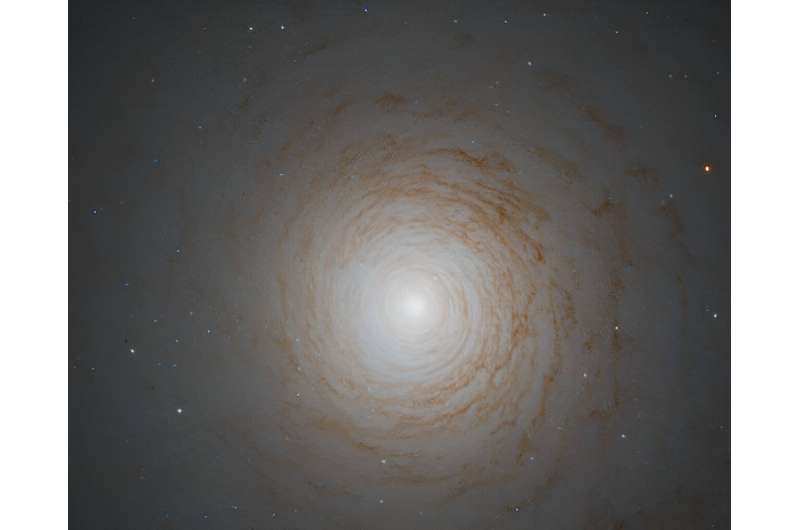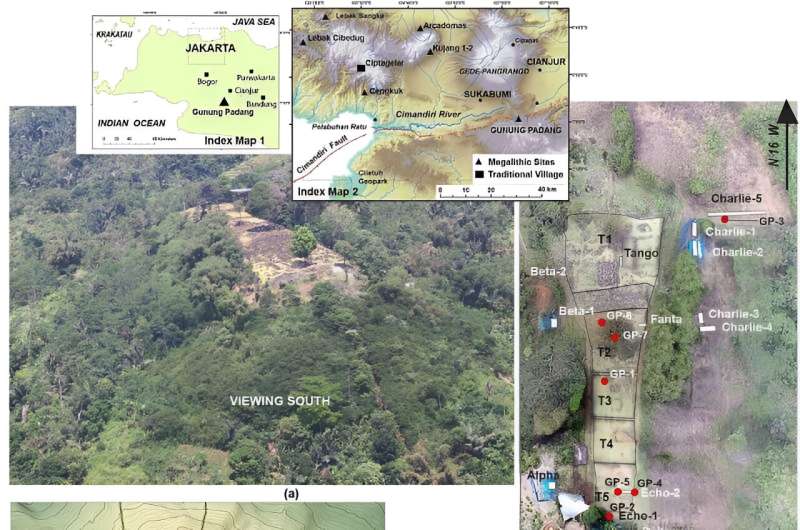December 11, 2023 report
This article has been reviewed according to Science X's editorial process and policies. Editors have highlighted the following attributes while ensuring the content's credibility:
fact-checked
peer-reviewed publication
trusted source
proofread
Best of Last Year: The top Phys.org articles of 2023

It was a good year for research across multiple fields as a team at the University of Ottawa, working with colleagues Danilo Zia and Fabio Sciarrino, from the Sapienza University of Rome, demonstrated a novel technique to visualize the wave function of two entangled photons, the elementary particles that constitute light, in real time. This work that could lead to accelerated quantum technology advancements.
Also, just last month, dual teams from Stanford and UC Berkeley led by Chan Zuckerberg with Biohub San Francisco Investigators announced evidence showing that starfish—rather than being mostly body—are actually, mostly head. The team used a variety of high-tech molecular and genomic techniques to better understand where different genes were expressed during the development and growth of sea stars.
Over the summer, astrophysicist Rajendra Gupta, with the University of Ottawa, reported evidence that the universe is nearly twice as old as current estimates posit—he claimed that allowing Zwick's tired light theory to co-exist with the expanding universe made it impossible to reinterpret the redshift seen with some stars such as a Methuselah, a hybrid phenomenon rather than expansion alone.
Also last summer, a trio of volcanologists and geologists from Lithium Americas Corporation, GNS Science and Oregon State University reported evidence that the McDermitt Caldera on the Nevada/Oregon border may host some of the largest known deposits of lithium on Earth. The find showed that the U.S. would not have to rely on other countries for supplies of the highly valued soft metal used in a wide variety of batteries.

And last winter, an international team of researchers announced evidence indicating that black holes are a source of dark energy—a finding that suggests nothing new needs to be added to our picture of the universe to account for dark energy—black holes combined with Einstein's gravity are the source.
And one of the hottest topics of the year arose when a team of physicists affiliated with several institutions in South Korea claimed to have created an elusive room-temperature/ambient-pressure superconducting material they called LK-99.
They posted two papers on the arXiv preprint server outlining their experiments and reasons for believing they had found a material that could conduct electricity without resistance at normal room temperatures—but unfortunately, they did so before seeking outside opinions.
That decision appeared to be ill-advised as research teams at other sites were unable to replicate the results, even as research looking for quantum zero resistant materials continued. The work by multiple teams around the world led to skepticism about the characteristics of LK-99, with one team finding that it was not even a metal.
Then, just last month, a team at the Institute of Physics of the Chinese Academy of Sciences shut down any remaining hope for LK-99 as a room temperature superconducting material when they found solid evidence proving that LK-99 was non-superconducting, effectively closing the door on the matter.
They also found that the material contained a certain amount of Cu2S impurity, which underwent a structural phase transition from a hexagonal structure at high temperature to a monoclinic structure at low temperature around 400 K. And they found that the resistivity of Cu2S decreased by three to four orders of magnitude around 385 K, close to the transition temperature reported in references.
In other news, a team of scientists in the U.K., led by groups at Imperial College London and the University of Nottingham, announced last month that they had completed construction of a synthetic chromosome as part of a major international project (called Sc2.0) to build the world's first synthetic yeast genome. The feat was considered by most in the field to be a major step toward creating the world's first synthetic yeast.
Last winter, a team at the University of California San Diego, found via experimentation, that UV-emitting nail polish dryers damage DNA and cause mutations in human cells. Their results suggest the popular nail drying devices, which are most often used in nail salons, may lead not just to cell death, but mutations that could lead to the development of cancerous tumors in people who use them.
Over the summer, a pair of psychologists at Niğde Ömer Halisdemir University found evidence that married couples who regularly engage in phone snubbing (phubbing) have lower marriage satisfaction than couples who do not. The pair used the results of questionnaires sent to married couples living in Turkey to find that couples who reported more phubbing in their home also reported less satisfaction in their marriages.
Last winter, three environmentalists with the Environmental Working Group, working with a colleague from Duke University's Nicholas School of the Environment, found evidence that eating a single fish caught in a river or lake in the United States is equivalent to drinking a month's worth of water contaminated with toxic forever chemicals—which amounted to levels of PFAS of 48 parts per trillion.

Also, a team of geneticists at Karolinska Institutet, in Sweden, working with colleagues from the University of Michigan and the Max Planck Institute for Evolutionary Anthropology, in Germany, reported that Dupuytren's disease is partly of Neanderthal origin. The condition leaves those afflicted with hands that bend into a permanently flexed position, most often affecting the ring and middle fingers.
And a team of chemical scientists from the University of Catania, SpringStyle Tech Design Ltd, Romania National Archives and Politecnico di Milano, Via Mancinelli, found evidence that Vlad the Impaler, (the ruler of Wallachia during part of the 15th century) may have suffered from a variety of illnesses, including one that could have made the famous prince cry tears mixed with blood. Many historians believe the count was the inspiration for the fictional character Dracula.
And a team at Complutense University, working with a colleague from the Prehistory and Archaeology Museum Cantabria and Prehistoric Caves of Cantabria, discovered an array of ancient cave paintings hidden among previously described cave art at La Pasiega cave, Cantabria. The cave art was found by using stereoscopic recordings to reveal missing details from the Paleolithic images.
A team of Earth scientists, archaeologists and environmentalists affiliated with several institutions across Europe and the U.K., working with a colleague from Canada, upended a century-old theory regarding the history of Stonehenge opening the door to more discoveries. They found that one of the stones, named stone 80, did not come from the same source as the other rocks that compose the monument. That calls into question theories that describe the source of the so-called Altar Stone, the old red sandstone formation of west Wales, which has been accepted for nearly 100 years.
And a trio of anthropologists from the University of Cambridge, University College London and SET CAMHS, NELFT, respectively, found evidence that hunter-gatherer infants received attentive care and physical contact for about nine hours per day from up to 15 different caregivers—an indication that prior to the modern era, infants and children received far more attention and care than they do today, leading to mother and child well-being.
Also, this past spring, an international team of biochemists and microbiologists reported an enzyme that turns air into electricity. The enzyme, called Huc, was found to pull hydrogen from the air and to use it to produce electricity. They also found that the process was extremely efficient, suggesting that it could be scaled up to provide electricity for general use.

And last month, a team of archaeologists, geophysicists, geologists and paleontologists affiliated with multiple institutions in Indonesia reported evidence that Gunung Padang is the oldest known pyramid in the world. For many years, it has been considered a megalithic structure. It sits on top of an extinct volcano in West Java and is considered by locals to be a sacred site.
And nearly a year ago, an international team of researchers from the Max Planck Institute for Evolutionary Anthropology in Leipzig, Germany, reported on new insights they had uncovered surrounding Bronze Age marriage rules and family structures in ancient Greece. Analyses of more than 100 ancient genomes for people living in the Aegean, showed that the choice of marriage partners was determined by one's kinship.
Over the summer, a team of archaeologists, civil engineers and cultural experts affiliated with multiple institutions across China reported evidence that China's ancient water pipe networks (dating back 4,000 years) were local communal efforts—they found no evidence of a centralized state authority. The pipes were made of ceramics and were built along with drainage ditches around the city of Pingliangtai.
Also last summer, a team of Earth scientists, geologists and infrastructure engineers with Seoul National University, working with colleagues from the University of Melbourne, Hong Kong Polytechnic University and the University of Texas at Austin, reported evidence that the amount of water pumped from the ground by human endeavors (2,150 gigatons) has slightly altered the Earth's spin by approximately 80 centimeters.
And more recently, James Dilger, a professor at Stony Brook University in New York, who specializes in the mechanisms of anesthetic action, found that the numbers behind published Wordle success rates did not quite add up. By doing some math calculations, he found that the odds of a person randomly guessing the day's word to be 0.043%, totaling 860 players. Yet, Times statistics showed that the number of players making correct first guesses in each game never dipped below 4,000. That difference, he suggests, can only be explained by cheating.
And a few months ago, a team at Duke University found an association between epidemic levels of chronic kidney disease in rural Sri Lanka and the use of the herbicide Roundup. They also found similar clusters of the same disease in people living in other farming communities around the world. Study of water in the wells in Sri Lanka showed the presence of glyphosate, the active compound in Roundup.
This past autumn, a team of Earth scientists at the University of Oxford, working with colleagues from EDYTEM-CNRS-University Savoie Mont Blanc and Durham University, found that ancient carbon sequestered in rocks around the globe release as much carbon dioxide as the world's volcanoes due to erosion. They were able to estimate the global release of carbon from rocks by feeding massive amounts of data into a supercomputer at Oxford and simulating the complex interplay of physical, chemical and hydrological processes.
Over the summer, a team of anthropologists and geneticists from several universities in the U.S., working with colleagues from the Smithsonian Institution and the Archaeological Society of Delaware conducted a DNA analysis of 17th-century remains uncovered at a Delaware dig site, finding kinship among European settlers and African slaves—evidence shows that the two groups had to work together to survive.
And finally, last month, officials at NASA announced that the U.S. would attempt to land a spacecraft on the surface of the moon. The craft, called Peregrine, is scheduled for launch on December 24 and is set to land on the surface of the moon on January 25. The lander was made by Astrobotic and its instruments will be used to assist with groundwork for the Artemis collaborative effort to put people on the moon again, tentatively scheduled for 2025.
Journal information: arXiv , Nature Photonics , Molecular Biology and Evolution
© 2023 Science X Network





















